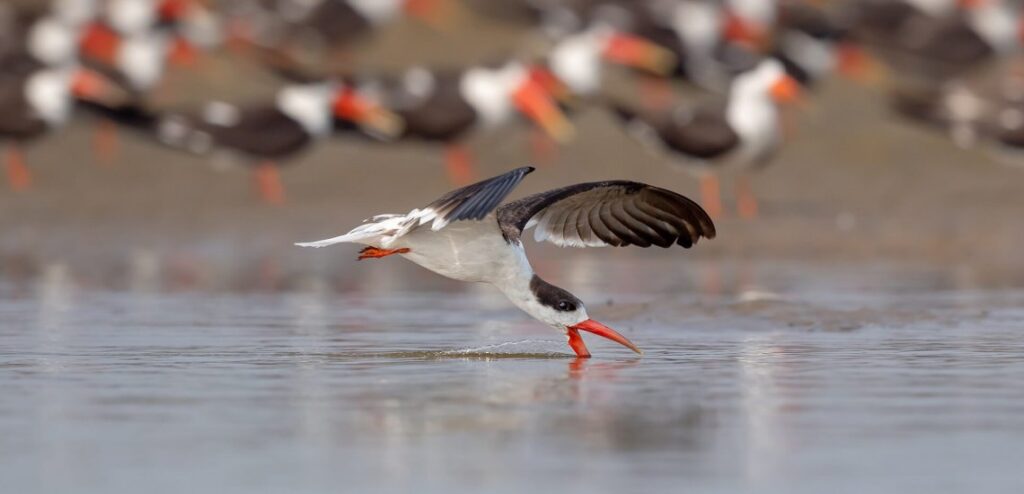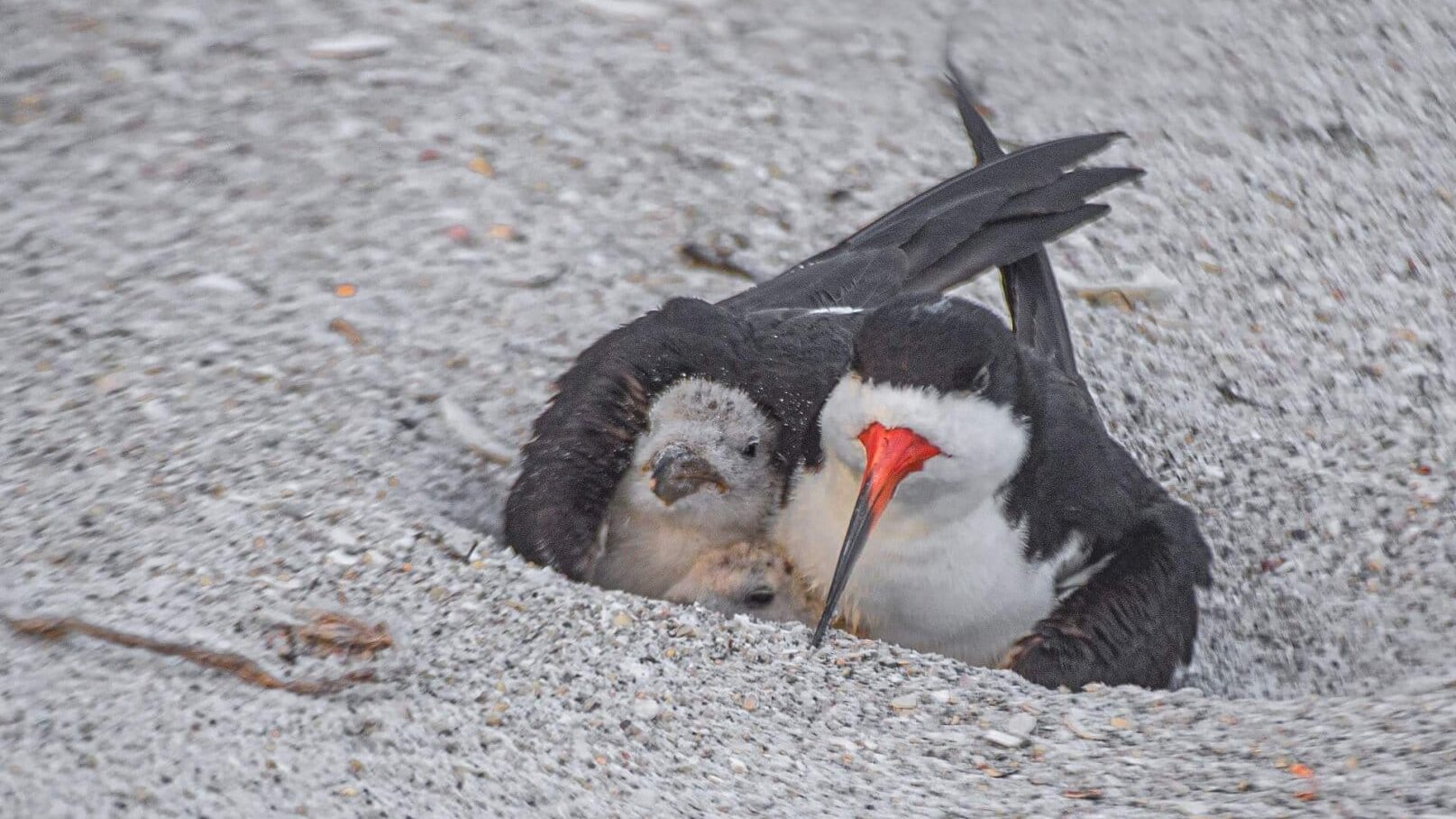Red List update: a glimmer of hope for the Indian Skimmer

Once found across South Asia, the Indian Skimmer is now restricted to a few key sites across India and Bangladesh – hence its recent classification as Endangered. Now, new evidence that the bird travels across borders indicates we’re only skimming the surface of what needs to be done…
By Neha Sinha, BNHS
This January, researchers in Bangladesh discovered Indian Skimmers on a survey in Nijhum Dwip National Park. Three of the birds had colour bands, tagged by the Bombay Natural History Society (BNHS, BirdLife in India). This confirmed what many had long suspected – that Indian Skimmers move between India and Bangladesh, and thus conservation of this globally threatened, tern-like bird must be coordinated at the flyway level.
The Indian Skimmer Rynchops albicollis is a black and white bird with a bright orange beak: an unmissable lower mandible that’s longer than the upper portion of the beak. This is a tool for the bird to skim the water surface, picking up small aquatic prey on the way. It nests on the ground, specifically on sandbars in rivers. It is an unforgettable bird, once you see it. Yet, the breeding grounds are shrinking from beneath the Indian Skimmer’s feet.
The species faces a bundle of threats. Sand mining, much of it illegal, is decimating skimmer habitat in India. Illegal sand mining has not just ravaged rivers, but also law and order – with forest department staff losing their lives to speeding sand mining trucks. Another threat is irrigation projects and dams – which can reduce water to a level that encourages other species to damage skimmer nests, or can flood nesting sites altogether. Chambal river, known to be India’s cleanest, is suffering a lack of ecological flow because of hydro projects. When water levels are very low, predators like free-ranging dogs can easily raid skimmer eggs and chicks.
In Bangladesh, the bird faces intrusion through agriculture, cattle, and direct human presence. Once found in Pakistan, Myanmar, Laos, Cambodia and Vietnam, the bird now appears to be mostly restricted to India and Bangladesh. The results of the first ever Indian Skimmer count, held on 19-20 January 2021 by BNHS and Bird Count India, found 1,609 birds from 45 locations. In India, 1,159 birds were counted, and a further 450 were counted in Bangladesh.
“In India, the fact that water is a contested resource has really affected the species,” says Parveen Shaikh, a research fellow for BNHS. “Habitats on the Ganga basin are majorly impacted – there are hardly any good breeding sites left for the Indian Skimmer.”
“Habitats on the Ganga basin are majorly impacted – there are hardly any good breeding sites left for the Indian Skimmer.”Parveen Shaikh, BNHS

BNHS has been working on nest protection of the species in Chambal sanctuary in Madhya Pradesh. Using a mosaic of sticks and fences, and using community members as nest protectors, the idea is to ensure the bird has nesting and recruitment success. The skimmer count shows us the most important congregation landscapes for the bird today in India: Phaphamau (on the river Ganga in Uttar Pradesh), Tikarpara, Satkosia and Badmul (over River Mahanadi in Odisha) Rozi Port, Jamnagar and Dhinchada in Gujarat, Kakinada in Andhra Pradesh, National Chambal Sanctuary over Rajasthan, Madhya Pradesh and Uttar Pradesh, and Nijhum Dweep National Park in Bangladesh.
Saving Indian Skimmers will conserve riverine ecosystems, which support many other sympatric species, such as the Black-bellied Tern Sterna acuticauda (Endangered). Present breeding records are noted from Pong Dam, River Chambal, River Son, River Ganges, Tawa Reservoir near Satpura Tiger Reserve in Madhya Pradesh and River Mahanadi.
“Anthropogenic activities in riverine ecosystems and overall habitat loss are causing population declines of many riverine breeding birds”, says conservation biologist Sayam U Chowdhary, who works in Bangladesh. “The dwindling Indian Skimmer numbers throughout the Indian subcontinent is a stark example of what is happening to other river dependent species.”
According to the Convention on Migratory Species’ information on the Central Asian Flyway, of which India and Bangladesh are a part, the flyway’s action plan should include the Indian Skimmer among species of ‘great significance’. This urgency is reflected in the Indian Skimmer’s recent uplisting to Endangered, and there is an urgent need to protect the last habitats left for it. To this effect, a concerted action plan under the CMS, and state-level actions would go a long way.
This long-term project has been made possible by generous support through The BirdLife Fund for the Conservation of Threatened Indian Birds, financed by BirdLife Species Champion Per Undeland.
Stay up to date
Sign up to receive the latest bird conservation news. You’ll also receive updates about our projects, science and other ways to get involved including fundraising.
Thank you for your support, we are committed to protecting your personal information and privacy. For more information on how we use your data, please see our Privacy Policy. You can unsubscribe from emails at any time by using the link in the footer of any email from us.

